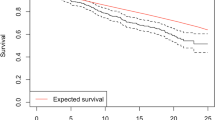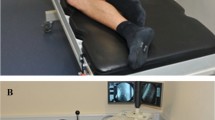Abstract
Purpose
To determine the prognostic value of preoperative Veterans RAND-12 (VR-12) Physical Composite Score (PCS) scores on postoperative clinical outcomes in patients undergoing lateral lumbar interbody fusion (LLIF).
Methods
LLIF patients were separated into 2 cohorts based on preoperative VR-12 PCS scores: VR-12 PCS < 30 (lesser physical function) and VR-12 PCS ≥ 30 (greater physical function). Patient-reported outcome measures (PROMs) of VR-12 PCS, VR-12 Mental Composite Score (MCS), Short Form-12 (SF-12) PCS, SF-12 MCS, Patient-Reported Outcomes Measurement Information System Physical Function (PROMIS-PF), Patient Health Questionnaire-9 (PHQ-9), Visual Analog Scale (VAS) Back Pain (VAS-BP), VAS Leg Pain (VAS-LP), and Oswestry Disability Index (ODI) were collected at preoperative and up to 2-year postoperative time points. Mean postoperative follow-up time was 16.69 ± 8.53 months. Minimum clinically important difference (MCID) achievement was determined by comparing ∆PROM to previously established thresholds.
Results
Seventy-eight patients were included, with 38 patients with lesser preoperative physical function scores. Patients with lesser physical function reported significantly inferior preoperative PROM scores in all domains, except for SF-12 MCS and VAS-LP. At the 6-week postoperative time point, patients with lesser physical function reported significantly inferior VR-12 PCS, VR-12 MCS, SF-12 PCS, PROMIS-PF, and PHQ-9. At the final postoperative time point, patients with lesser physical function reported significantly inferior VR-12 PCS, VR-12 MCS, PROMIS-PF, PHQ-9, and ODI. Magnitude of 6-week postoperative improvement was significantly higher in the lesser physical function cohort for VR-12 PCS.
Conclusion
Patients undergoing LLIF with worse baseline VR-12 PCS scores reported inferior postoperative physical function, mental health, and disability outcomes. At the final postoperative follow-up, magnitude of postoperative improvement and MCID achievement did not significantly differ. Baseline VR-12 PCS scores may indicate inferior postoperative clinical outcomes in physical function, mental health, and disability in patients undergoing LLIF; however, baseline VR-12 PCS does not limit the magnitude of postoperative improvement.
Similar content being viewed by others
Data availability
The findings presented in this study are available upon request from the corresponding principle investigator, Kern Singh at kern.singh@rushortho.com.
Abbreviations
- ASA :
-
American Society of Anesthesiologists
- BMI :
-
Body mass index
- CCI :
-
Charlson Comorbidity Index
- LLIF :
-
Lateral lumbar interbody fusion
- MCID :
-
Minimum clinically important difference
- MCS :
-
Mental Component Score
- MIS :
-
Minimally invasive surgery
- ODI :
-
Oswestry Disability Index
- OME :
-
Oral morphine equivalents
- ORA :
-
Office of Regulatory Affairs
- PCS :
-
Physical Component Score
- PHQ-9 :
-
Patient Health Questionnaire-9
- POD :
-
Postoperative day
- PROMIS-PF :
-
Patient-Reported Outcomes Measurement Information System Physical Function
- PROMs :
-
Patient-reported Outcome Measures
- SF-12 :
-
12-Item Short Form
- TLIF :
-
Transforaminal lumbar interbody fusion
- VAS :
-
Visual Analog Scale
- VAS-BP :
-
Visual Analog Scale Back Pain
- VAS-LP :
-
Visual Analog Scale Leg Pain
- VR-12 :
-
Veterans RAND-12
References
Fong DYT, Chan BKY, Li S, Wan CH, Kazis LE (2022) Average and individual differences between the 12-item MOS Short-form Health Survey version 2 (SF-12 vol 2) and the veterans RAND 12-item Health Survey (VR-12) in the Chinese population. Health Qual Life Outcomes 20(1):102. https://doi.org/10.1186/s12955-022-02010-z
Jenkins NW, Parrish JM, Nolte MT, Hrynewycz NM, Brundage TS, Singh K (2020) Validating the VR-12 physical function instrument after anterior cervical discectomy and fusion with SF-12, PROMIS, and NDI. HSS J 16(2_suppl):443–451. https://doi.org/10.1007/s11420-020-09817-w
Jenkins NW, Parrish JM, Lynch CP et al (2021) Association of preoperative physical function and changes in mental health after minimally invasive transforaminal lumbar interbody fusion. Int J Spine Surg 15(6):1115–1122. https://doi.org/10.14444/8197
Kowalski KL, Lukacs MJ, Mistry J, Goodman M, Rushton AB (2022) Physical functioning outcome measures in the lumbar spinal surgery population and measurement properties of the physical outcome measures: protocol for a systematic review. BMJ Open 12(6):e060950. https://doi.org/10.1136/bmjopen-2022-060950
Lynch CP, Cha EDK, Jenkins NW et al (2021a) The minimum clinically important difference for patient health questionnaire-9 in minimally invasive transforaminal interbody fusion. Spine 46(9):603–609. https://doi.org/10.1097/BRS.0000000000003853
Lynch CP, Cha EDK, Mohan S, Geoghegan CE, Jadczak CN, Singh K (2021) Two-year validation and minimal clinically important difference of the Veterans RAND 12 Item Health Survey Physical Component Score in patients undergoing minimally invasive transforaminal lumbar interbody fusion. J Neurosurg Spine 36(5):731–740. https://doi.org/10.3171/2021.6.SPINE21231
Lynch CP, Cha EDK, Jenkins NW et al (2021c) Validation of VR-12 physical function in minimally invasive lumbar discectomy. World Neurosurg 155:e362–e368. https://doi.org/10.1016/j.wneu.2021.08.062
Mobbs RJ, Phan K, Malham G, Seex K, Rao PJ (2015) Lumbar interbody fusion: techniques, indications and comparison of interbody fusion options including PLIF, TLIF, MI-TLIF, OLIF/ATP, LLIF and ALIF. J Spine Surg 1(1):2–18. https://doi.org/10.3978/j.issn.2414-469X.2015.10.05
Ngo J, Mousselli M, Lee YP (2022) Cage and graft options in lateral lumbar interbody fusion. Semin Spine Surg 34(2):100943. https://doi.org/10.1016/j.semss.2022.100943
Nie JW, Hartman TJ, MacGregor KR, Oyetayo OO, Zheng E, Singh K (2023) Minimum clinically important difference in patients undergoing minimally invasive transforaminal lumbar interbody fusion. Neurosurgery. https://doi.org/10.1227/neu.0000000000002350
Nunley P, Sandhu F, Frank K, Stone M (2016) Neurological complications after lateral transpsoas approach to anterior interbody fusion with a novel flat-blade spine-fixed retractor. Biomed Res Int 2016:8450712. https://doi.org/10.1155/2016/8450712
Parker SL, Adogwa O, Paul AR et al (2011) Utility of minimum clinically important difference in assessing pain, disability, and health state after transforaminal lumbar interbody fusion for degenerative lumbar spondylolisthesis. J Neurosurg Spine 14(5):598–604. https://doi.org/10.3171/2010.12.SPINE10472
Parrish JM, Jenkins NW, Lynch CP et al (2021) Preoperative physical function association with mental health improvement after anterior cervical discectomy and fusion. Clin Spine Surg 34(10):E559–E565. https://doi.org/10.1097/BSD.0000000000001232
Patel DV, Bawa MS, Haws BE, Khechen B, Block AM, Karmarkar SS, Lamoutte EH, Singh K (2019) PROMIS Physical Function for prediction of postoperative pain, narcotics consumption, and patient-reported outcomes following minimally invasive transforaminal lumbar interbody fusion. J Neurosurg Spine 1:1–7. https://doi.org/10.3171/2018.9.SPINE18863
Pawar A, Hughes A, Girardi F, Sama A, Lebl D, Cammisa F (2015) Lateral lumbar interbody fusion. Asian Spine J 9(6):978–983. https://doi.org/10.4184/asj.2015.9.6.978
Salzmann SN, Shue J, Hughes AP (2017) Lateral lumbar interbody fusion-outcomes and complications. Curr Rev Musculoskelet Med 10(4):539–546. https://doi.org/10.1007/s12178-017-9444-1
Schalet BD, Rothrock NE, Hays RD et al (2015) Linking physical and mental health summary scores from the veterans RAND 12-item health survey (VR-12) to the PROMIS® Global Health Scale. J Gen Intern Med 30(10):1524–1530. https://doi.org/10.1007/s11606-015-3453-9
Yoo JS, Jenkins NW, Parrish JM, Brundage TS, Hrynewycz NM, Mogilevsky FA, Singh K (2020) Evaluation of postoperative mental health outcomes in patients based on patient-reported outcome measurement information system physical function following anterior cervical discectomy and fusion. Neurospine 17(1):184–189. https://doi.org/10.14245/ns.1938256.128
Author information
Authors and Affiliations
Contributions
Omolabake O. Oyetayo, BS: Conceptualization, Methodology, Visualization, Formal Analysis, Software, Investigation, Writing – Original Draft, Writing – Review & Editing
James W. Nie, BS: Conceptualization, Methodology, Visualization, Formal Analysis, Software, Investigation, Writing – Original Draft, Writing – Review & Editing
Timothy J. Hartman, MD: Conceptualization, Methodology, Visualization, Formal Analysis, Software, Investigation, Writing – Review & Editing
Keith R. MacGregor, BS: Project Administration, Data Curation, Investigation, Writing – Review & Editing
Eileen Zheng, BS: Project Administration, Data Curation, Investigation, Writing – Review & Editing
Fatima N. Anwar, BA: Conceptualization, Methodology, Supervision, Resources, Investigation, Writing – Review & Editing
Andrea M. Roca, MA: Conceptualization, Methodology, Supervision, Resources, Investigation, Writing – Review & Editing
Vincent P. Federico, MD: Conceptualization, Methodology, Supervision, Resources, Investigation, Writing – Review & Editing
Dustin H. Massel, MD: Conceptualization, Methodology, Supervision, Resources, Investigation, Writing – Review & Editing
Arash J. Sayari, MD: Conceptualization, Methodology, Supervision, Resources, Investigation, Writing – Review & Editing
Gregory D. Lopez, MD: Conceptualization, Methodology, Supervision, Resources, Writing – Review & Editing
Kern Singh, MD: Conceptualization, Methodology, Supervision, Resources, Investigation, Writing – Review & Editing
Corresponding author
Ethics declarations
Ethical approval
This study was performed in line with the principles of the Declaration of Helsinki. Approval was granted by the Institutional Review Board (IRB) of Rush University Medical Center (ORA #14051301).
Financial interests
Kern Singh, MD receives royalties from Zimmer Biomet, Stryker, RTI Surgical, Lippincott Williams and Wilkins, Thieme, Jaypee Publishing, and Slack Publishing. Kern Singh, MD owns stock in Avaz Surgical LLC and Vital 5 LLC. Kern Singh, MD holds a consulting position with Zimmer Biomet and K2M. Kern Singh, MD holds board membership with Vital 5 LLC. Kern Singh, MD is on the editorial board of Contemporary Spine Surgery. Kern Singh, MD received a research grant from the Cervical Spine Research Society.
Non-financial interests
Kern Singh, MD holds board membership with TDi LLC and Minimally Invasive Spine Study Group and receives no compensation as board member. Kern Singh, MD is on the editorial board of Orthopedics Today and Vertebral Columns and receives no compensation as member of the editorial board. Kern Singh, MD is on the board of directors of Cervical Spine Research Society, International Society for the Advancements of Spine Surgery, and American Academy of Orthopaedic Surgeons and receives no compensation as member of the board of directors.
Informed consent
Informed consent was obtained from all individual participants included in the study.
Additional information
Publisher's note
Springer Nature remains neutral with regard to jurisdictional claims in published maps and institutional affiliations.
This article is part of the Topical Collection on Spine—Other
Rights and permissions
Springer Nature or its licensor (e.g. a society or other partner) holds exclusive rights to this article under a publishing agreement with the author(s) or other rightsholder(s); author self-archiving of the accepted manuscript version of this article is solely governed by the terms of such publishing agreement and applicable law.
About this article
Cite this article
Oyetayo, O.O., Nie, J.W., Hartman, T.J. et al. Effect of baseline veterans RAND-12 physical composite score on postoperative patient-reported outcome measures following lateral lumbar interbody fusion. Acta Neurochir 165, 3531–3537 (2023). https://doi.org/10.1007/s00701-023-05763-8
Received:
Accepted:
Published:
Issue Date:
DOI: https://doi.org/10.1007/s00701-023-05763-8




